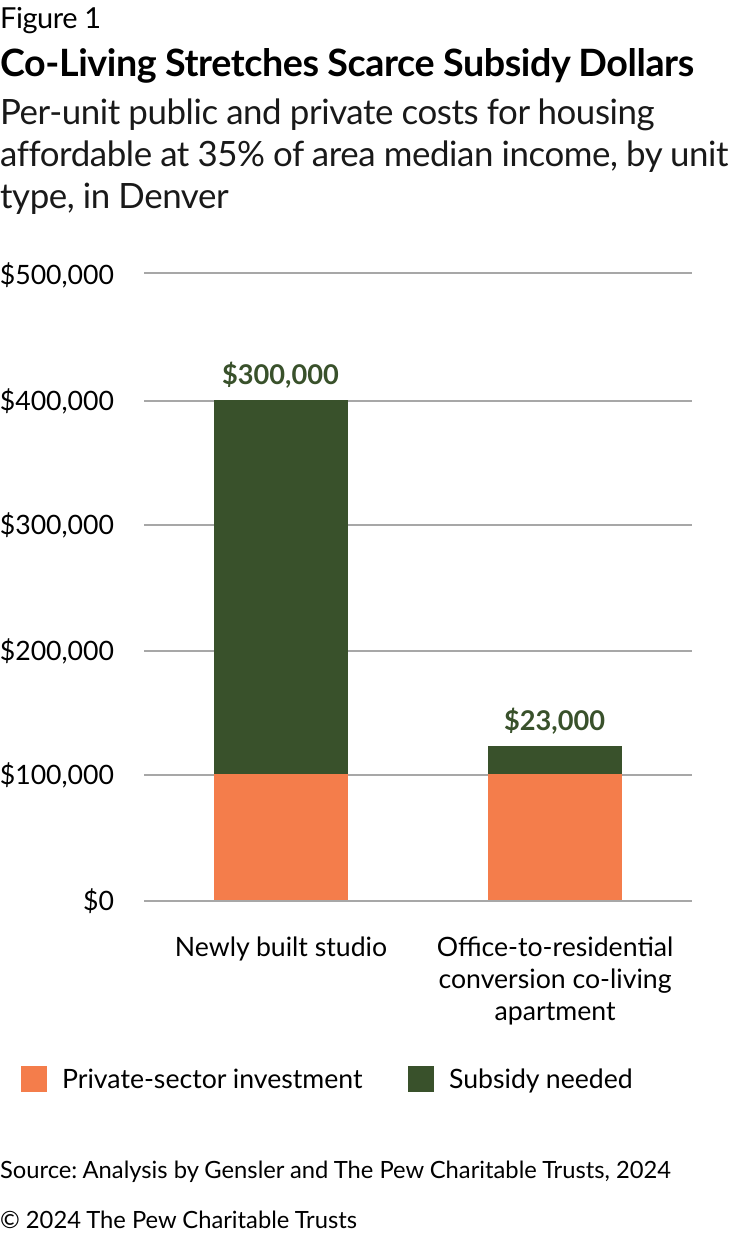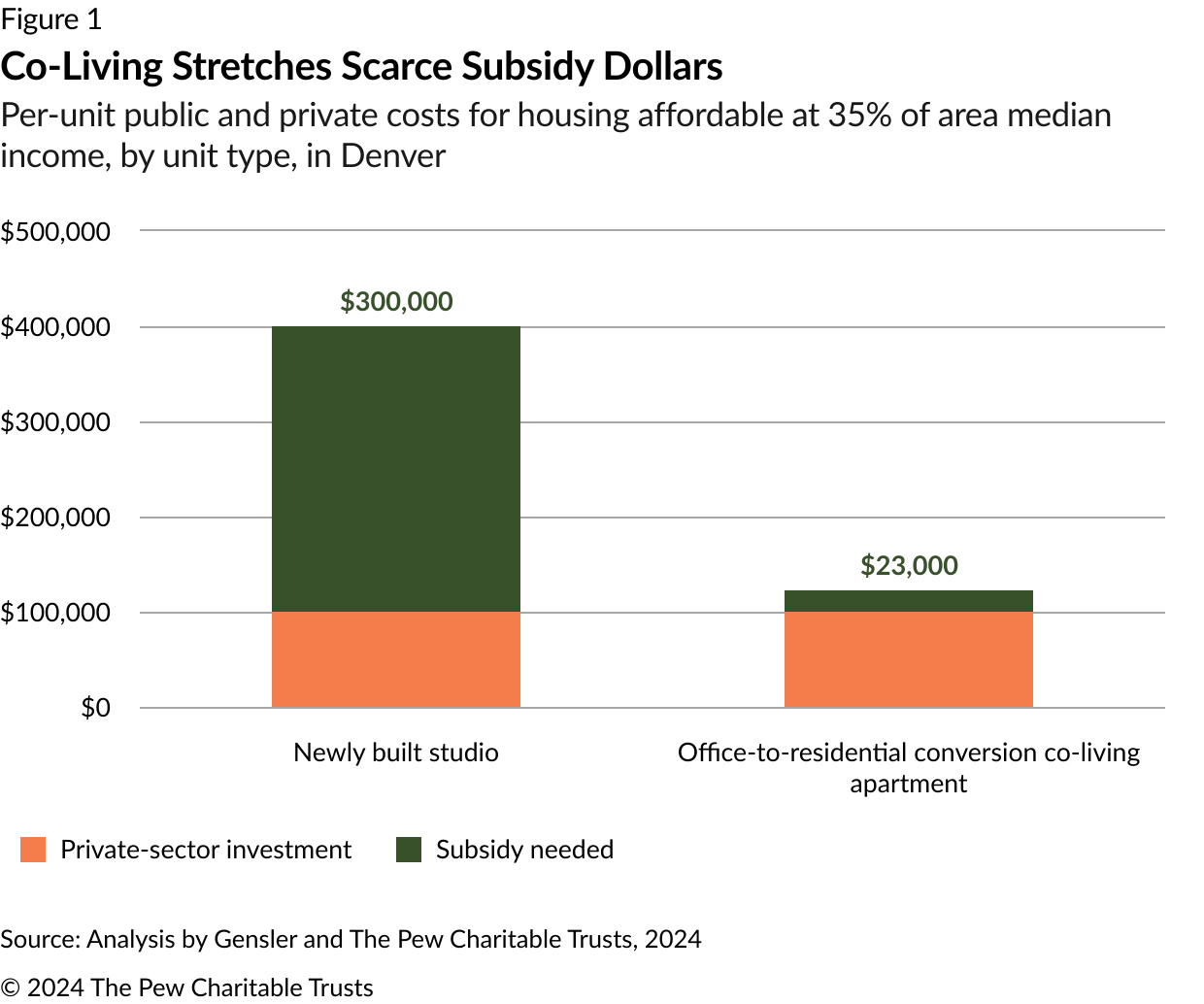Co-Living Could Unlock Office-to-Residential Conversions
New research finds efficient method to add low-cost, downtown housing

The United States has a shortage of 4 million to 7 million homes and, at the same time, an all-time-high office vacancy rate of 20%, meaning that more than a billion square feet of office space is unused. But despite the urgent need for housing—and many local policymakers’ desire to convert underused office space to apartments to help revitalize downtowns that lost residents and businesses during the pandemic—construction costs remain too high to make most such conversions profitable, even with today’s high market rents in many U.S. cities and towns.
But new research from The Pew Charitable Trusts and Gensler, a global architecture, design, and planning firm, has identified a more economically viable approach to office-to-residential conversions using a design that reduces construction costs and enables low rents that are affordable for people earning well below an area’s median income. Rather than conventional apartments, the design calls for converting buildings to co-living dorm-style apartments. Each floor features private, locked “microunits” along the perimeter, with shared kitchens, bathrooms, laundry, and living rooms in the center.
Adding large amounts of this low-cost, downtown housing would provide a much-needed option for students, service-industry workers, young professionals, veterans, new arrivals in a city, and retirees. It would also reduce homelessness. And because of these units’ small size, the current low prices for office buildings, and the efficient layout, this housing could be created near jobs and transit at a fraction of the cost of traditional houses or apartments.
The analysis shows major benefits of the co-living design. Concentrating the plumbing and kitchens in the center of each floor (where they usually already are in offices), rather than in each unit, and other savings from this building style trims the construction costs by roughly 25% to 35% versus conventional office-to-apartment conversions. Because the microapartments are narrow and deep, every resident would have a large window, but each floor would accommodate roughly three times as many units as a typical apartment building.
The additional units mean slightly more total revenue than with typical apartments or older office buildings. But the anticipated rents would be lower than studio apartments and typically affordable for people earning less than half the area median income. And converting vacant buildings in downtown areas would provide residents access to jobs and public transportation without cars, relieve strain on their budgets, and expand their economic opportunities, while also preserving the look and feel of residential neighborhoods because it uses existing buildings away from single-family blocks.
Further, converted offices could be configured so that residents have keycard access only to their own floor, creating small communities. This also could enable leasing of an individual floor for dedicated purposes, such as to a university for supplemental dorm space, to a hospital for temporary staff housing, or to a city for permanent supportive housing for residents who were previously homeless. Converted buildings would also need 24-hour security even though typical apartment buildings do not have it. Operating costs would be higher than a conventional apartment building, but landlords would be able to defray costs for security and cleaning of common areas across the large number of tenants.
Beyond the general analysis, Gensler and Pew identified buildings in Denver, Minneapolis, and Seattle that are suitable for co-living conversion and developed floor plans for each, factoring in mechanical, electrical, and plumbing systems. Turner Construction, a multinational firm with expertise in construction cost analysis, estimated the conversion costs on a per-unit and per-square foot basis. Based on those findings, Gensler projected the total cost to build out a co-living building in Denver at about $123,000 per unit; by comparison, constructing a studio apartment in Denver affordable to a low-income resident costs about $400,000.
Like most American cities, the three examined here are all experiencing housing shortages and high median rents: $1,781 in Denver, $1,387 in Minneapolis, and $2,091 in Seattle. But based on market dynamics and what people earning 30% to 50% of the area median income can afford, the anticipated rents for the microapartments (typically 120 to 180 square feet) would be roughly half those figures.
Creating this new lower rung on the housing ladder that is attainable for those who cannot afford a rent increase in their current homes also would help curb the flow of previously housed residents into homelessness. Previous Pew research has found that housing costs are the primary driver of homelessness. Further, co-living development could improve housing access for people with federal Section 8 vouchers, who often cannot find landlords willing to accept their vouchers in the current environment of housing scarcity.
Pew and Gensler also found the conversions could be feasible with some combination of the following: an investor comfortable with a modest rate of return, a somewhat below-market rate loan, a subsidy from a city or philanthropy, or a building that can receive a historic tax credit. However, the anticipated rate of return would not be high enough to attract capital from private equity or similar investors if none of these conditions are met.
On the other hand, co-living development could save taxpayers money by reducing homelessness and stretching government subsidies by developing housing at lower cost. (See Figure 1.) For example, $100 million in subsidies in Denver could produce either 330 new-construction studio apartments or about 4,300 office-to-co-living conversion units. And a 2023 Pew survey found that converting underused commercial space into housing is also popular with the public.

Of course, converting office buildings into co-living housing has challenges. Although less costly and faster than other office-to-residential conversions, developing these homes still is a major undertaking, requiring the reconfiguring of all core building systems and installation of high-quality soundproofing between rooms. And developing effective management practices for this new style of housing will be critical.
In addition, although regulations in Denver, Minneapolis, and Seattle already allow such conversions, many other cities’ zoning or building codes present barriers, most commonly in the form of parking minimums, minimum unit sizes, maximum numbers of co-living units per building, or even outright prohibitions on co-living (or sometimes any residential) in commercial areas.
Nevertheless, the potential payoff—revitalized downtowns, reduced homelessness, improved housing affordability, and more economic opportunity—could be substantial. And although office-to-residential conversions have so far been limited, this new research identifies a cost-effective path forward that could enable cities that see even a few converted high- or midrise buildings to realize benefits as soon as the buildings are fully leased. Ironically, low-cost housing, rather than high-end conversions, may be the most financially feasible option for the nation’s underused office space.
Alex Horowitz is a project director and Tushar Kansal is a senior officer with The Pew Charitable Trusts’ housing policy initiative.

















